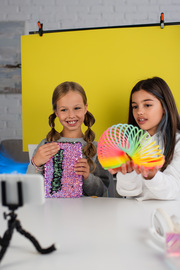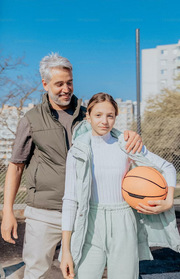Kids As Social Media Influencers
Everybody is using social media platforms these days, and these platforms have become essential factors in people’s everyday lives. People make many of their daily decisions based on what influencers say on Instagram, TikTok, and YouTube Influencers’ effect on people’s vital decisions makings undeniable.
One of the phenomenons of social media platforms in the new era is kid influencers, who are children with thousands and millions of followers with solid online exposure.
Kid influencers have become controversial, and there are many debates regarding how ethical it is to let kids become influencers. Moreover, with the existence of online bullies and assaulters, how safe is it to let our children become kid influencers? If you have the same questions, we are here to answer them all. In this article, we will discuss the advantages and disadvantages of letting your kids become influencers, and we will also talk about some tips for parental control. We will also introduce some of the most successful kid influencers for your reference. So, continue reading, and you will get the answers you seek.
Should we allow our kids to become influencers?
As social media platforms develop, many job opportunities have emerged for people in different age ranges, such as children, to become an influencer. As we all know, influencers can become rich and famous, but besides all these advantages, should we as parents motivate children to become an influencer?
All families have their own beliefs and attitude; as a result, it depends on the family to decide about their child to start and follow a career as an influencer. Parents should evaluate the drawbacks of this career and know that their children will face many responsibilities and pressure on this path.
Parents need to make sure that their kids can handle the pressure of content creation and manage the time they need to be active on social media and the time they should spend with friends and family. Parents are the only s who can realize if they can face bullies everywhere in the online world. Eventually, parents should evaluate the advantages and disadvantages of this job and talk to their children about it before making any decisions.
Even though most influencers, no matter what age group, seem happy and successful, it makes sense that many parents are still worried about their children being part of this culture. Of course, any kid can become successful as an influencer, but parents should always pay attention to their mental health and emotional growth. Counseling for teens can help young influencers cope with the stress and expectations that come with their public persona. The fact that influencers should always look perfect and create engaging daily content can lead to lots of stress and anxiety, which can eventually impact a child in the wrong way.
Parents should compare the pros and cons of letting their child become an influencer. If you agree about your child becoming an influencer, you have to talk to them constantly about their feelings and experiences to make wise decisions.
Tips for Parents
Here are tips for parents who agree their kids will become influencers.
Find out about the programs and apps your child is using.
Parents should be aware of the programs and apps their child uses as an influencer. You must learn about these tools’ features and privacy options because they can help you set some limitations and rules for your child’s online activities. Talk to your child about how to use these technologies and learn how to use monitoring tools to make sure they are safe while staying online.
Be enthusiastic about your child’s online life and ask questions.
You must become engaged in your child’s online presence as a parent like you are involved in their offline life. Talk to your children about what they like to do online, what websites they are interested in, what they will post on their accounts, and who they are in touch with online.
When interacting with your child, you will show interest in their behavior. You can supervise their online activity simultaneously to ensure any danger does not threaten them.
You should communicate with your child and make non-destructive boundaries, and keep them informed about being responsible.

Keep tablets and computers where you can see when your child is using them.
Parents always want to ensure their children are safe, especially in this digital era. Still, kids should be able to access different technologies, such as smartphones and tablets. In addition, it is necessary to supervise them while they are using these technologies.
One method that can help you as a parent is to put these devices where you can see them in the house. The reason is that you can supervise or monitor them while using these gadgets. Moreover, your child will feel more comfortable because they know you are there next to them if they need help or support.
You can put these devices in living rooms or the kitchen, where ever you and your child feel more comfortable, which can be a thoughtful way to ensure your child’s safety.
Social media parental control tools
The safety of children in today’s digital world is the most crucial thing that all parents should care about. Different Instagram parental control tools can assist parents in supervising their children’s activity in the online world.
Parents can use built-in parental control features on social media platforms such as Instagram, Facebook, and Twitter. This feature will help parents limit certain content, block users, and restrict their child’s app usage.
Parents can also use third-party parental control tools such as Family Time, Boomerang, Qustodio, etc. You can customize the tools based on your priorities for your child’s safety. For example, you can block websites, supervise their emails and text messages, and even set time limitations for screen usage.
You should be honest and transparent with your children about using this software and explain that you are doing this to ensure their online safety on social media platforms. Because, ethically, you should use these tools with their consent and not behind their backs. With an open conversation with your child, you can describe their social media roles and responsibilities and ensure they follow these rules to stay safe.
Here are the top social media parental control tools:
- Qustodio
- Aura
- Bark
- Canopy
- Kaspersky Safe Kids
- Kidslox
- Net Nanny
- eyeZy
- Norton Family Premier
Top Kid Influencers
Young influencers are mastering social media platforms, and we can say this is a beginning of a new era. These children have millions of followers on social media platforms such as Instagram and YouTube. For example, Ryan Kaji is an 11 years old kid influencer with over 34 million subscribers on his YouTube channel Ryan’s World, proving that all children can become influencers. It is anticipated that the number of young influencers is expected to increase in the new year, and they will become famous and wealthy by gaining more audience worldwide. Based on predictions, a big wave of kid influencers will master social media platforms by 2023. On the other hand, there are still many ethical debates regarding kids’ participation in this industry. Many experts are worried about the consequences and pressures of this job on children’s physical and mental health.
Niana Guerrero
Nian Guerrero, AKA Niana Jose Evidente Guerrero, is a 17 years old Filipino dancer and singer on social media. Many of her dance moves with her brother Ranz Kyle have become viral.
Everybody loved her spectacular dance moves and high energy. She started dancing when she was very young and worked harder every day to improve so her audience could enjoy her activities. Today, she is one of the most loved dancers in the world, and she inspires many people and children.
She has millions of followers around the world who are following her passionately. She also covers some of the most famous and challenging dance moves, which many people of different ages and genders have welcomed.
Niana also sings besides dancing; her voice has brought tears to people’s eyes as she has an impressive and touching voice. She wants to make people feel good as she has a cheerful and bright personality, and making people happy also makes her happy.
Niana always tries to communicate with her fans, share her affection in dancing, and to sing with others. She has inspired so many people so far, and she will become one of the biggest stars in the future.
Elle Lively McBroom
Elle is a six years old American YouTuber, and she is the child of Austin McBroom and Cathrine Paiz. She is very popular, and many people love her because of her cute face.
She has a sweet personality, and so many people adore her. Her parents share some sneak peeks of her life on their family vlog and are very proud of their little girl.
She has many followers despiting her young age, and her fans always look forward to her appearing on McBroom’s family vlog. Elle always brings smiles to her followers’ faces by singing, dancing, and showing her adorable antics.
She has a bright future ahead as a very young Youtuber, and we are waiting to see what she will bring to her fans in the following years to come, and we are excited to witness her flourish as a star very soon.
Fateh Halilintar
Fateh is a 17 years old Indonesian influencer, and he has more than 5 million followers around the world. He shares photos and videos of his everyday life with his followers and has two more accounts for his extra content.
With the explosive growth of social media platforms, it is no wonder that kids like Fateh have more than 5 million followers and are gaining more attention every day. Fateh tries so hard to share engaging and exciting content with his followers and wants his fans to enjoy scrolling through his social media accounts.
Even though his main social media account is exploding with engaging content, he has increased his activity on social media by adding two more backup accounts for more refreshing content. Undoubtedly, Fateh will continue surprising his fans and inspiring them with his unique and compelling personality.
Conclusion
Social media platforms are one of the most significant assists beyond the traditional entertainment industry, which can help many people start their brands and affect many people globally. Still, if you are considering letting your child become a social media influence, you must consider many factors, weigh their pros and cons, and guarantee your child’s mental and physical health.
Parents are responsible for setting up understandable instructions, talking to their children about online safety, and knowing how to use parental control tools and features. Because at the end of the day, nothing is more important than your child’s well-being and safety, and they should always be your top priority. To learn more about kid influencers, check out our list of top influencers and their incredible stories.












